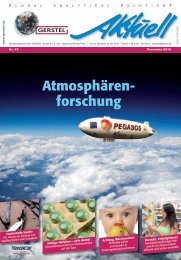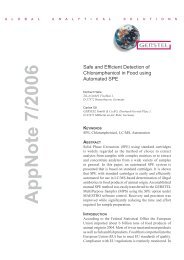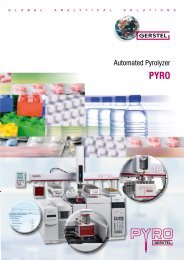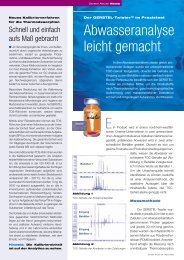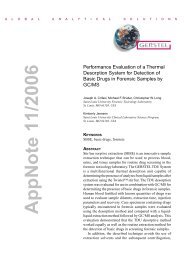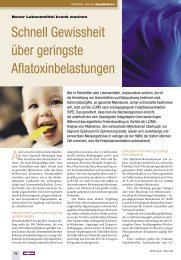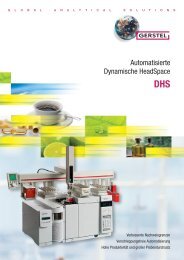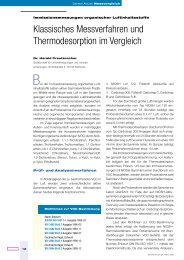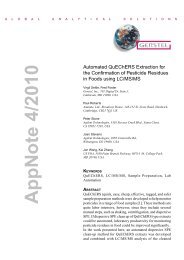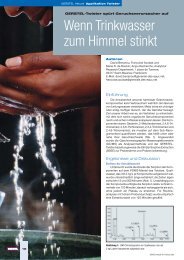an-1996-05 - Gerstel
an-1996-05 - Gerstel
an-1996-05 - Gerstel
You also want an ePaper? Increase the reach of your titles
YUMPU automatically turns print PDFs into web optimized ePapers that Google loves.
AppNote 5/<strong>1996</strong><br />
The Use of a Multipurpose Sampler for<br />
Headspace GC-MS Analysis of Volatile<br />
Org<strong>an</strong>ic Compounds in Hum<strong>an</strong> Urine<br />
<strong>an</strong>d Plasma<br />
H<strong>an</strong>s Günther Wahl, Anke Chrz<strong>an</strong>owski, Dieter Luft,<br />
H<strong>an</strong>s-Ulrich Häring<br />
Medizinische Universitätsklinik, Abt.IV, D-72076 Tübingen, Germ<strong>an</strong>y<br />
Andreas Hoffm<strong>an</strong>n<br />
<strong>Gerstel</strong> GmbH & Co.KG, Eberhard-<strong>Gerstel</strong>-Platz 1,<br />
D-45473 Mülheim <strong>an</strong> der Ruhr, Germ<strong>an</strong>y<br />
KEYWORDS<br />
Capillary Gas Chromatography, GC-MS, Multi Purpose<br />
Sampler, Headspace, Volatiles, 4-Hept<strong>an</strong>one, 2-Ethyl-1-<br />
hex<strong>an</strong>ol, DEHP, Urine, Plasma
ABSTRACT<br />
A multi-purpose-sampler (<strong>Gerstel</strong> MPS), designed for liquid large volume, gaseous <strong>an</strong>d headspace<br />
samples was used for the GC-MS <strong>an</strong>alysis of org<strong>an</strong>ic volatiles in hum<strong>an</strong> urine <strong>an</strong>d plasma. Headspace<br />
sampling with a volume, temperature <strong>an</strong>d speed controlled gas tight syringe was combined with a<br />
temperature controlled cooled injection system for cold trapping, enrichment <strong>an</strong>d focussing of <strong>an</strong>alyte.<br />
Regular 2 ml GC-vials filled with 1 ml acidified urine or plasma were used as headspace sampling vials.<br />
A 100 vial autosampler tray was equipped with <strong>an</strong> additional temperature <strong>an</strong>d heating time controlled<br />
preheating station for 5 vials. Profiles of org<strong>an</strong>ic volatiles were determined <strong>an</strong>d 4-hept<strong>an</strong>one as a ketone<br />
of medical interest was qu<strong>an</strong>tified. Calibration curves <strong>an</strong>d imprecision of the urine method for<br />
4-hept<strong>an</strong>one concentrations in the r<strong>an</strong>ge from 40 to 800 ng/ml showed a correlation coefficient of<br />
r = 0,9980 <strong>an</strong>d a coefficient of variation (CV) between 3.0 <strong>an</strong>d 3.4% respectively. In this pilot study<br />
including 92 patients with diabetes mellitus (Type I <strong>an</strong>d II) <strong>an</strong>d 51 controls the medi<strong>an</strong> for the diabetic<br />
group was 179 ng/l compared to 188 ng/l in the control group. Further studies have to show if there<br />
actually exsists a relationship between 4-hept<strong>an</strong>one <strong>an</strong>d diabetes mellitus - or if the origin of 4-<br />
hept<strong>an</strong>one is solely environmental. A possible source could be the widespread plasticizer Di-(2-ethyl<br />
hexyl)phthalate (DEHP), which in vivo could be hydrolyzed <strong>an</strong>d oxidized to the corresponding β-ketoacid.<br />
Spont<strong>an</strong>eously <strong>an</strong>d upon heating this acid would yield 4-hept<strong>an</strong>one. All major intermediates have<br />
now been found <strong>an</strong>d identified in serum <strong>an</strong>d urine. First results from hum<strong>an</strong> studies under current<br />
investigations show in fact that the plasticizer DEHP is the origin of elevated 4-hept<strong>an</strong>one concentrations<br />
in urine <strong>an</strong>d plasma of patients receiving intravenously applied infusions.<br />
INTRODUCTION<br />
The concept of "metabolic profiling" has been widely applied in general to all different kinds of<br />
biological fluids such as urine, serum, cerebrospinal fluid, amniotic fluid, breast milk <strong>an</strong>d to tissue<br />
homogenates [1-3]. Next to the org<strong>an</strong>ic acid fraction in urine <strong>an</strong>d serum the profiles of org<strong>an</strong>ic volatiles<br />
have been intensively studied <strong>an</strong>d linked to metabolic disorders [4-10]. The profile of org<strong>an</strong>ic volatiles<br />
in urine covers a diverse group of different polarity: alcohols, aldehydes, ketones, O- <strong>an</strong>d N-<br />
heterocycles, sulfur containing compounds (isocy<strong>an</strong>ates, sulfides) <strong>an</strong>d hydrocarbons are found regularly<br />
<strong>an</strong>d may be derived from nutrients, intermediates or environmental contamin<strong>an</strong>ts [11]. Pattern<br />
recognition of profiles [5] <strong>an</strong>d especially the concentration of several ketones [6, 12], such as 4-<br />
hept<strong>an</strong>one [8, 13] were related to diabetes mellitus. In diabetic patients elevated levels of 4-hept<strong>an</strong>one<br />
in urine were found <strong>an</strong>d tentatively related to more specific stages of the disease [8, 13]. A possible<br />
relationship also was found between endogenous volatile urinary metabolites with structures similar to
certain neurotoxins [14] <strong>an</strong>d the development of the diabetic polyneuropathy [10, 15].<br />
The sampling techniques used for the <strong>an</strong>alysis of org<strong>an</strong>ic volatiles include static <strong>an</strong>d dynamic<br />
headspace with condensation in a cryogenic trap [16, 17] or adsorption onto the hydrophobic porous<br />
polymer Tenax (poly 2,6-diphenyl-p-phenylene oxide) [5, 8, 18, 19], solvent extraction [4, 13] <strong>an</strong>d the<br />
use of a tr<strong>an</strong>sevaporator [20-22]. Modifications have also be done concerning the instrumentation<br />
[23, 24]. Next to the GC-MS other selective detectors for complex sulfur, nitrogen, phosphorous or<br />
halogen c<strong>an</strong> be very useful in headspace <strong>an</strong>alysis [25]. Ch<strong>an</strong>ges in the composition of the volatile sulfur<br />
containing compounds in the urine of diabetic persons c<strong>an</strong> reliable be registered by use of a sulfur<br />
detector [25]. Mercapt<strong>an</strong>es such as meth<strong>an</strong>thiole, eth<strong>an</strong>thiole, dimethyl sulfide <strong>an</strong>d dimethyl disulfide<br />
c<strong>an</strong> result from the enterobacterial degradation of methionine in the state of hepatic encephalophaty, but<br />
may also in some extent be due to sulfur compounds (meth<strong>an</strong>thiole, dimethyl disulfide) found in coffee<br />
[26].<br />
EXPERIMENTAL<br />
Sample preparation. A total of 189 urine samples (spont<strong>an</strong>eous <strong>an</strong>d 24h collecting period) were taken<br />
from 51 healthy controls <strong>an</strong>d 92 diabetic patients. 2ml GC vials were filled with aliquots of 1 ml acidified<br />
(30μl conc. HCL) urine <strong>an</strong>d <strong>an</strong>alyzed in duplicates. Serum samples were collected from patients with<br />
diabetes, liver diseases <strong>an</strong>d on hemodialysis.<br />
Instrumentation. The applied system consists of a Multi Purpose Sampler (<strong>Gerstel</strong> GmbH, Mülheim <strong>an</strong><br />
der Ruhr, Germ<strong>an</strong>y), operated in headspace-mode <strong>an</strong>d equipped with a 1000 μl gas tight syringe, a<br />
HP-7673 tray for 2ml st<strong>an</strong>dard vials (Hewlett-Packard, Waldbronn, Germ<strong>an</strong>y) plus <strong>an</strong> additional<br />
pre-heating module for 5 vials with control of temperature <strong>an</strong>d heating-time (<strong>Gerstel</strong> GmbH, Mülheim<br />
<strong>an</strong> der Ruhr, Germ<strong>an</strong>y), a temperature controlled cold injection system CIS-3, (<strong>Gerstel</strong> GmbH, Mülheim<br />
<strong>an</strong> der Ruhr, Germ<strong>an</strong>y) used as interface, cold trap <strong>an</strong>d injection system for the subsequently following<br />
GC-MSD combination (HP 5890/5972, Hewlett-Packard, Waldbronn, Germ<strong>an</strong>y).<br />
Injector<br />
Heatable<br />
Syringe<br />
Tray<br />
Heatable<br />
Turret<br />
Pre-heating<br />
Module<br />
CIS<br />
Figure 1. <strong>Gerstel</strong> Multi Purpose Sampler in st<strong>an</strong>dby (left) <strong>an</strong>d injection mode (right).
Operation. Each sample is heated for the same period of time at the same temperature in the pre-heating<br />
module. Solvent flushing of the MPS with helium is done by injecting the special designed syringe into<br />
the CIS-3 for 8 min. The heated syringe c<strong>an</strong> then be filled with a defined volume of helium <strong>an</strong>d injected<br />
into the headspace vial. The depht of injection is controlled for both the position in the vial <strong>an</strong>d in the<br />
injector. The sample is injected into the cooled CIS-3 for focussing <strong>an</strong>d enrichment <strong>an</strong>d after heating<br />
up to the desired temperature tr<strong>an</strong>sferred to the capillary column in either split or splitless mode.<br />
Qu<strong>an</strong>tification of 4-hept<strong>an</strong>one in urine. Acidified pooled urine samples spiked with 4-hept<strong>an</strong>one were<br />
used for the calibration curves in a concentration r<strong>an</strong>ge from 40 to 800 ng/ml.The ion m/z 71.15 was used<br />
for qu<strong>an</strong>tification <strong>an</strong>d the ions m/z 43.1 <strong>an</strong>d m/z 114.15 were used as qualifier ions for the identification.<br />
Intra assay imprecision of the method was determined for different urine samples in the observed<br />
concentration r<strong>an</strong>ge by measuring 10 aliquots from each sample in a row.<br />
Analysis conditions.<br />
Column: 60 m DB-5 (J&W), d i<br />
=0.25 mm, d f<br />
=0.25<br />
Pneumatics: Carriergas He, pi =100 kPa, split x:30,<br />
Temperatures:<br />
Detector:<br />
HSS pre-heating module: 70°C (10 min)<br />
HSS turret: 70°C<br />
HSS syringe: 70°C<br />
CIS:<br />
Oven:<br />
MSD: 280°C<br />
MSD, sc<strong>an</strong> 10-260 amu<br />
1 min splitless<br />
-150°C; with 12°C/s to 300°C (3 min)<br />
60°C; with 5°C/min to 100°C;<br />
with 25°C/min to 240°C<br />
RESULTS AND DISCUSSION<br />
Identification. Figure 2 shows the chromatogram from <strong>an</strong> acidified urine sample of a healthy person.<br />
Without acidifying the number of peaks is signific<strong>an</strong>t smaller, but on the other h<strong>an</strong>d some peaks become<br />
more prominent as is the case for allylisothiocy<strong>an</strong>ate. The identified volatiles are listed in Table I.<br />
Abund<strong>an</strong>ce<br />
400000<br />
300000<br />
200000<br />
100000<br />
Time--><br />
3.00 4.00 5.00 6.00 7.00 8.00 9.00<br />
Figure 2. Chromatogram of acidified urine sample from healthy person.
Volatiles<br />
RT (min)<br />
Volatiles<br />
RT (min)<br />
Acetone<br />
2-But<strong>an</strong>one<br />
Chloroform<br />
Benzene<br />
Cyclohexene<br />
2-Pent<strong>an</strong>one<br />
2,5-Dimethylfur<strong>an</strong><br />
Phenol<br />
3-Methyl-1-but<strong>an</strong>ol<br />
Dimethyl disulfide<br />
Toluene<br />
3-Hex<strong>an</strong>one<br />
2-Ethyl-5-methylfur<strong>an</strong><br />
Tetrachloro ethylene<br />
5-Methyl-3-hex<strong>an</strong>one<br />
3-Hept<strong>an</strong>one<br />
4-Hept<strong>an</strong>one<br />
Cyclohex<strong>an</strong>ol<br />
2.23<br />
2.73<br />
2.87<br />
3.29<br />
3.45<br />
3.56<br />
3.78<br />
3.98<br />
4.11<br />
4.20<br />
4.52<br />
4.75<br />
4.94<br />
5.06<br />
5.43<br />
5.45<br />
5.90<br />
6.07<br />
Allylisothiocy<strong>an</strong>ate<br />
Chloro cyclohex<strong>an</strong>e<br />
2-Hept<strong>an</strong>one<br />
2,4-Dimethyl thiophene<br />
Methyl-2-propenyl disulfide<br />
Methyl propyl disulfide<br />
3-Methyl-2-hept<strong>an</strong>one<br />
Dimethyl trisulfide<br />
Phell<strong>an</strong>drene<br />
1,4-Dichloro benzene<br />
α-Terpinene<br />
1-Methyl-2-(1-methyl ethyl)<br />
benzene<br />
γ-Terpinene<br />
4-Methyl phenol<br />
α-Terpinolene<br />
3-Methyl hex<strong>an</strong>e-2-one<br />
6.10<br />
6.13<br />
6.16<br />
6.36<br />
6.56<br />
6.71<br />
6.87<br />
7.23<br />
7.66<br />
7.69<br />
7.80<br />
7.90<br />
8.31<br />
8.50<br />
8.64<br />
8.86<br />
RT: retention time<br />
Table I. Identified volatiles in hum<strong>an</strong> urine.<br />
The <strong>an</strong>alysis of ketones is of clinical relev<strong>an</strong>ce in metabolic disorders, especially in the case of diabetes<br />
mellitus. Next to methylketones, found at elevated levels in ketoacidosis 4-hept<strong>an</strong>one proved to be <strong>an</strong><br />
interesting metabolite [8,13]. Figure 3 shows <strong>an</strong> extracted ion chromatogram (m/z 43) of <strong>an</strong> urine<br />
specimen from a healthy control person, which c<strong>an</strong> be chosen to monitor the following ketones:<br />
2-prop<strong>an</strong>one (1), 2-but<strong>an</strong>one (2), 2-pent<strong>an</strong>one (3) <strong>an</strong>d 4-hept<strong>an</strong>one (4), which is often accomp<strong>an</strong>ied by<br />
a smaller peak of 2-hept<strong>an</strong>one (5).<br />
Abund<strong>an</strong>ce<br />
60000<br />
50000<br />
40000<br />
30000<br />
1<br />
3<br />
1 2-Prop<strong>an</strong>one<br />
2 2-But<strong>an</strong>one<br />
3 2-Pent<strong>an</strong>one<br />
4 4-Hept<strong>an</strong>one<br />
5 2-Hept<strong>an</strong>one<br />
4<br />
20000<br />
10000<br />
0<br />
Time--><br />
2<br />
4.00 6.00 8.00 10.00<br />
5<br />
Figure 3. Extracted ion chromatogram (m/z 43), urine sample from healthy person.
Qu<strong>an</strong>tification. The calibration curve for 4-hept<strong>an</strong>one in urine was linear in the r<strong>an</strong>ge from 40 to 800<br />
ng/ml with a correlation coefficient of r = 0,9980. The determination of intra assay imprecision showed<br />
a coefficient of variation (CV) between 3.0 <strong>an</strong>d 3.4% for the total concentration r<strong>an</strong>ge.<br />
Clinical study. The medi<strong>an</strong> concentration of 4-hept<strong>an</strong>one in urine from the healthy control group was<br />
188 ng/ml, r<strong>an</strong>ging from 27 to 1044 ng/ml compared to 179 ng/ml, r<strong>an</strong>ging from 17 to 978 ng/ml in the<br />
diabetic patient group (Figure 4). The diabetic patient group was rather inhomogenous regarding<br />
duration, metabolic control <strong>an</strong>d type of diabetes <strong>an</strong>d there was no signific<strong>an</strong>t correlation to <strong>an</strong>y of these<br />
parameters.<br />
40%<br />
30%<br />
Diabetes patient group<br />
Control patient group<br />
20%<br />
10%<br />
0<br />
0-100<br />
100-200<br />
200-300<br />
300-400<br />
400-500<br />
ng/ml<br />
500-600<br />
600-700<br />
700-800<br />
800-900<br />
900-1000<br />
Figure 4. Distribution of urinary 4-hept<strong>an</strong>one concentrations.<br />
In the group of healthy controls 4 persons had very high concentrations of 4-hept<strong>an</strong>one in urine:<br />
1390 ng/ml, 1650 ng/ml, 1780 ng/ml <strong>an</strong>d 3720 ng/ml. As there is no difference in the medi<strong>an</strong><br />
concentration of 4-hept<strong>an</strong>one between the diabetic <strong>an</strong>d the control group <strong>an</strong>d considering the highly<br />
elevated levels in a few controls the source of 4-hept<strong>an</strong>one might be solely environmental. A possible<br />
source could be the widespread plasticizer 1,2-benzenedicarboxylic acid-bis-(2-ethylhexyl)-ester<br />
(DEHP), which in vivo could be hydrolyzed <strong>an</strong>d then oxidized to the corresponding β-keto-acid<br />
excreted in urine. Spont<strong>an</strong>eously <strong>an</strong>d upon heating this acid would yield 4-hept<strong>an</strong>one <strong>an</strong>d 2-hept<strong>an</strong>one.<br />
First results from studies under current investigations show the plasticizer DEHP to be the origin of 4-<br />
hept<strong>an</strong>one as well as 2-hept<strong>an</strong>one in hum<strong>an</strong> urine <strong>an</strong>d plasma. As DEHP is a common plasticizer used<br />
in medical tubings the elevated level in patients of intensive care units <strong>an</strong>d on hemodialysis c<strong>an</strong> easily<br />
be explained. In a pilot study a healthy control person was infused 500 ml NaCl in a regular infusion set,<br />
which was shown to contain DEHP as plasticizer. Specimens of 24 hours urine collected before <strong>an</strong>d after<br />
the infusion were <strong>an</strong>alyzed for the content of 4-hept<strong>an</strong>one:<br />
4-hept<strong>an</strong>one (μg/24h)<br />
before infusion<br />
after infusion<br />
236<br />
685
Serum samples. Serum samples were <strong>an</strong>alyzed for the presence of alcohols <strong>an</strong>d ketones, especially for<br />
4-hept<strong>an</strong>one <strong>an</strong>d 2-ethyl hex<strong>an</strong>ol. Samples from patients undergoing hemodialysis <strong>an</strong>d patients with<br />
liver diseases showed increased levels of both, further indicating DEHP to be its possible source. Figure<br />
5 shows the SIM-chromatogram of a serum sample from a critical ill patient in the intensive care unit<br />
of our hospital. Figures 6 <strong>an</strong>d 7 show the mass spectra of 4-hept<strong>an</strong>one (6) <strong>an</strong>d 2-ethyl hex<strong>an</strong>ol (7).<br />
Abund<strong>an</strong>ce<br />
10000<br />
4-hept<strong>an</strong>one<br />
2-ethyl hex<strong>an</strong>ol<br />
8000<br />
6000<br />
4000<br />
2000<br />
Time--><br />
0<br />
4.00 5.00 6.00 7.00 8.00 9.00 10.00 11.00 12.00 13.00<br />
Figure 5. Selected ion monitoring chromatogram of serum sample from critical ill patient.<br />
Abund<strong>an</strong>ce<br />
71<br />
150000<br />
43<br />
100000<br />
m/z--><br />
50000<br />
0<br />
41<br />
58<br />
30 40 50 60 70<br />
80<br />
86<br />
90<br />
99<br />
100<br />
110<br />
114<br />
Figure 6. Mass spectrum of 4-hept<strong>an</strong>one (RT 6.3 min).
Abund<strong>an</strong>ce<br />
57<br />
2000<br />
m/z--><br />
1000<br />
0<br />
31<br />
30<br />
41<br />
40<br />
45<br />
50<br />
70 83<br />
98<br />
112<br />
60 70 80 90 100 110<br />
Figure 7. Mass spectrum of 2-ethyl-1-hex<strong>an</strong>ol (RT 10.2 min).<br />
CONCLUSION<br />
With the method described org<strong>an</strong>ic volatiles in hum<strong>an</strong> urine <strong>an</strong>d plasma c<strong>an</strong> now be easily <strong>an</strong>alyzed.<br />
Applications are metabolic profile studies in a qualitative as well as qu<strong>an</strong>titative way. For 4-hept<strong>an</strong>one<br />
as one example high precision <strong>an</strong>d sensitivity of the method was shown. First results from hum<strong>an</strong> studies<br />
under current investigations show that the plasticizer DEHP is the origin of elevated 4-hept<strong>an</strong>one<br />
concentrations in urine <strong>an</strong>d plasma of patients receiving intravenously applied infusions.<br />
The high practicality in a day to day routine together with the cost cutting philosophy of a multi<br />
purpose sampler makes this automated system very attractive for clinical routine use in <strong>an</strong>alysis of<br />
org<strong>an</strong>ic volatiles.<br />
REFERENCES<br />
[1] E. Jellum, O. Stokke, <strong>an</strong>d L. Eldjarn, Clin Chem 18, (1972) 800-809.<br />
[2] E. Jellum, J Chromatogr 143, (1977) 427-462.<br />
[3] H.M. Liebich, J Chromatogr Biomed Appl 146, (1978) 185-196.<br />
[4] A. Zlatkis <strong>an</strong>d H.M. Liebich, Clin Chem 17, (1971) 592-594.<br />
[5] G. Rhodes, M. Miller, M.L. McConnell, <strong>an</strong>d M. Novotny, Clin Chem 27/4, (1981) 580-585.<br />
[6] M.L. Holl<strong>an</strong>d, G. Rhodes, D. Wiesler, <strong>an</strong>d M. Novotny, J Chromatogr 306, (1984) 23-37.<br />
[7] A. Zlatkis, W. Bertsch, H.A. Lichtenstein, A. Tishbee, F. Shunbo, H.M. Liebich, M. Coscia,<br />
<strong>an</strong>d M. Fleischer, Anal Chem 45, (1973) 763-767.<br />
[8] H.M. Liebich <strong>an</strong>d O. Al-Babbili, J Chromatogr 112, (1975) 539-550.<br />
[9] H.M. Liebich <strong>an</strong>d J. Wöll, J Chromatogr 142, (1977) 5<strong>05</strong>.<br />
[10] A.G. Baker, B. Jemiolo, D. Wiesler, <strong>an</strong>d M.V. Novotny, Fifteenth International Symposium<br />
on Capillary Chromatography, 1731. P. S<strong>an</strong>dra, Ed. Dr. Alfred Huethig Verlag Heidelberg ,<br />
Riva, (1993).<br />
[11] A. Zlatkis, R.S. Brazell, <strong>an</strong>d C.F. Poole, Clin Chem 27/6, (1981) 789-797.<br />
[12] G. Rhodes, M.L. Holl<strong>an</strong>d, D. Wiesler, <strong>an</strong>d M. Novotny, J Chromatogr 228, (1982) 33-42.<br />
[13] H.M. Liebich <strong>an</strong>d G. Huesgen, J Chromatogr 126, (1976) 465-474.
[14] G.D. DiVincenzo, C. Kapl<strong>an</strong>, J., <strong>an</strong>d J. Dedinas, Toxicology <strong>an</strong>d Applied Pharmacology 36,<br />
(1976) 511-522.<br />
[15] G. Rhodes, M.L. Holl<strong>an</strong>d, D. Wiesler, M. Novotny, S.A. Moore, R.G. Peterson, <strong>an</strong>d<br />
D.L.Felten, Experentia 38, (1982) 75-77.<br />
[16] T. Niwa, K. Meada, T. Ohki, A. Saito <strong>an</strong>d K. Kobayashi, Clin Chim Acta 110, (1981) 51-57<br />
[17] A.B. Robinson, D. Partridge, M. Turner, R. Ter<strong>an</strong>ishi, <strong>an</strong>d L. Pauling, J Chromatogr 85,<br />
(1973) 19-29.<br />
[18] M.L. McConnell <strong>an</strong>d M. Novotny, J Chromatogr 112, (1975) 559-571.<br />
[19] A. Zlatkis, H.A. Lichtenstein, A. Tishbee, W. Bertsch, F. Shunbo, <strong>an</strong>d H.M. Liebich,<br />
J Chromatogr Sci 11, (1973) 299-302.<br />
[20] A. Zlatkis <strong>an</strong>d K. Kim, J Chromatogr 126, (1976) 475-485.<br />
[21] K.Y. Lee, D. Nurok, <strong>an</strong>d A. Zlatkis, J Chromatogr 158, (1978) 377-386.<br />
[22] A. Zlatkis, C.F. Poole, R.S. Brazell, D.A. Bayfus, <strong>an</strong>d P.S. Spencer, J Chromatogr Biomed<br />
Appl 182, (1980) 137-145.<br />
[23] Z. Penton, Fifteenth International Symposium on Capillary Chromatography, 373. P. S<strong>an</strong>dra,<br />
Ed. Dr. Alfred Huethig Verlag Heidelberg, Riva, (1993).<br />
[24] R. Barcarolo, P. Casson, <strong>an</strong>d C. Tutta, Fifteenth International Symposium on Capillary<br />
Chromatography, 365. P. S<strong>an</strong>dra, Ed. Dr. Alfred Huethig Verlag Heidelberg, Riva, (1993).<br />
[25] B.V. Ioffe <strong>an</strong>d A.G. Vitenberg, Head-Space Analysis <strong>an</strong>d Related Methods in Gas<br />
Chromatography, 215. Anonymous, Ed. John Wiley & Sons, New York Chichester Brisb<strong>an</strong>e<br />
Toronto Singapore, (1983).<br />
[26] C.P. Bicchi, A.E. Binello, M.M. Legovich, G.M. Pellegrino, <strong>an</strong>d A.C. V<strong>an</strong>ni, J Agric Food<br />
Chem 41, No. 12, (1993) 2324-2328.<br />
“For research use only. Not for use in diagnostic procedures.”<br />
The information provided for this product is intended for reference <strong>an</strong>d research purposes only. GERSTEL offers no<br />
guar<strong>an</strong>tee as to the quality <strong>an</strong>d suitability of this data for your specific application.<br />
Information, descriptions <strong>an</strong>d specifications in this publication are subject to ch<strong>an</strong>ge without notice.
GERSTEL GmbH & Co. KG<br />
Eberhard-<strong>Gerstel</strong>-Platz 1<br />
D-45473 Mülheim <strong>an</strong> der Ruhr<br />
Germ<strong>an</strong>y<br />
+49 (0) 208 - 7 65 03-0<br />
+49 (0) 208 - 7 65 03 33<br />
gerstel@gerstel.com<br />
www.gerstel.com<br />
GERSTEL Worldwide<br />
GERSTEL, Inc.<br />
701 Digital Drive, Suite J<br />
Linthicum, MD 21090<br />
USA<br />
+1 (410) 247 5885<br />
+1 (410) 247 5887<br />
sales@gerstelus.com<br />
www.gerstelus.com<br />
GERSTEL AG<br />
Wassergrabe 27<br />
CH-6210 Sursee<br />
Switzerl<strong>an</strong>d<br />
+41 (41) 9 21 97 23<br />
+41 (41) 9 21 97 25<br />
gerstel@ch.gerstel.com<br />
www.gerstel.ch<br />
GERSTEL K.K.<br />
1-3-1 Nak<strong>an</strong>e, Meguro-ku<br />
Tokyo 152-0031<br />
SMBC Toritsudai Ekimae Bldg 4F<br />
Jap<strong>an</strong><br />
+81 3 5731 5321<br />
+81 3 5731 5322<br />
info@gerstel.co.jp<br />
www.gerstel.co.jp<br />
GERSTEL LLP<br />
Level 25, North Tower<br />
One Raffles Quay<br />
Singapore 048583<br />
+65 6622 5486<br />
+65 6622 5999<br />
SEA@gerstel.com<br />
www.gerstel.com<br />
GERSTEL Brasil<br />
Av. Pascoal da Rocha Falcão, 367<br />
04785-000 São Paulo - SP Brasil<br />
+55 (11)5665-8931<br />
+55 (11)5666-9084<br />
gerstel-brasil@gerstel.com<br />
www.gerstel.com.br<br />
Information, descriptions <strong>an</strong>d specifications in this<br />
Publication are subject to ch<strong>an</strong>ge without notice.<br />
GERSTEL, GRAPHPACK <strong>an</strong>d TWISTER are registered<br />
trademarks of GERSTEL GmbH & Co. KG.<br />
© Copyright by GERSTEL GmbH & Co. KG<br />
Awarded for the<br />
active pursuit of<br />
environmental sustainability



